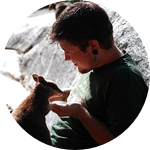About This Project
Lichens, formed from the symbiotic relationship between a fungus and an algae, are fascinating yet often overlooked organisms. In particular, very little is known about dispersal and population structuring. The goal of our study, focusing on the common british soldier lichen (Cladonia cristatella) is to increase the understanding of how lichens disperse through the environment and how local populations are genetically structured.Ask the Scientists
Join The DiscussionWhat is the context of this research?
While lichens are almost everywhere, they are one of the most overlooked organisms in the environment. What many people simply dismiss as a "moss", bark or the pattern on a rock is actually a lichen! These intrepid organism are actually the result of individuals from at least two different kingdoms of life living as a single symbiotic organism. The resulting composite organism is capable of dwelling in habitats that neither could effectively colonize on their own.
However, because these amazing organisms are so often overlooked we know relatively little about how they actually exist. How does an organism that is actually two organisms successfully reproduce and disperse through the landscape?
What is the significance of this project?
A better understanding about the basic biological and ecological aspects of lichens is vital because many species are known to be sensitive to the air pollution that seems to inevitably follow where humans encroach on nature. The basic knowledge needed for conservation decisions is minimal. How can we make a plan to conserve organism when we do not really understand how they behave in the environment.
This study will help increase the understanding of the dispersal patterns of lichens in their natural settings. We will try to uncover their real potential - how far can they spread? That can tell us how fast can they recover when disturbed habitat is restored.
What are the goals of the project?
To further the basic understanding of lichen biology and answer our questions about dispersal and lichen ecology we will strive to achieve several things:
- Collect and analyse the mitochondrial DNA of a common lichen (Cladonia cristatella) to examine broad scale dispersal and genetic structuring patterns (currently underway)
- Develop microsatellite DNA markers to look even deeper, at a finer scale, than goal one.
- Conduct an intensive biological survey to document and identify all lichens present within a single locale. This will help provide data on occurrence, abundance, habitat requirements and lichen community structuring.
- Involve undergraduate research students in all aspects of goals 1-3 in order to provide them with valuable real world research training and education.
- Share that knowledge!
Budget
We are seeking funding to help fill in some fundamental gap in the scientific knowledge about these amazing organisms. The largest portion of the budget represents the costs in developing and trialing new microsatellite DNA markers*. These markers will complement the mitochondrial DNA markers already in use by our team and allow us to probe the depth of our questions even further.
The remainder of the budget represents the basic costs associated with running any new genetics project (sampling supplies, chemicals, gloves, pipette tips, etc.).
*Microsatellites are little bits of repetitive DNA that are found throughout an organism's genome (about 3% of Human DNA is made up of different microsatellites). The cool thing about these bits of DNA is that how many times a particular microsatellite is repeated can vary between individuals within a population. This means that measuring the number of times different microsatellites occur can tell you all kinds of information, such as how closely individuals are related to each other, how much genetic diversity is in a population (more is generally better) and even how closely whole populations or species are related.
Meet the Team
Team Bio
My name is Dr. Stephen H Kolomyjec and I am an Assistant Professor in the Department of Biology at Ohio Northern University. A population geneticist by training, my doctoral research investigated population structure in the platypus with a distinct focus on those inhabiting northern Queensland, Australia (See the Nat Geo Video Here) . My research demonstrated the genetic impact of long standing geological isolation on Northern, Southern, and Tasmanian platypus populations.I have extensive and practical field experience on three continents (North America, Australia and southern Africa).
My personal research interests and activities include mammalian natural history, semi-aquatic freshwater mammals, the role of individuals in shaping the genetics of populations, and lichen biology.
Additional Information


Project Backers
- 7Backers
- 8%Funded
- $395Total Donations
- $56.43Average Donation
